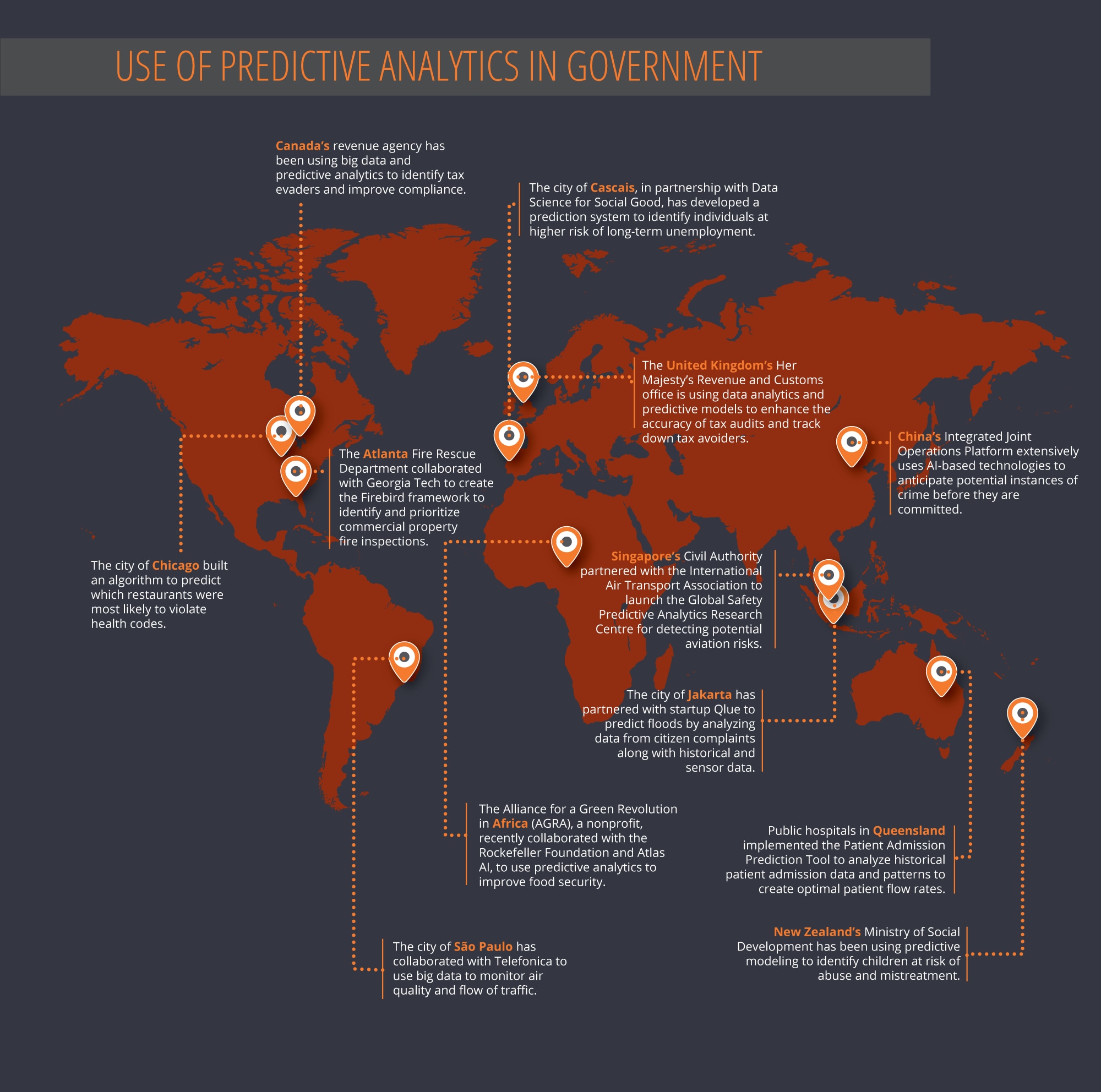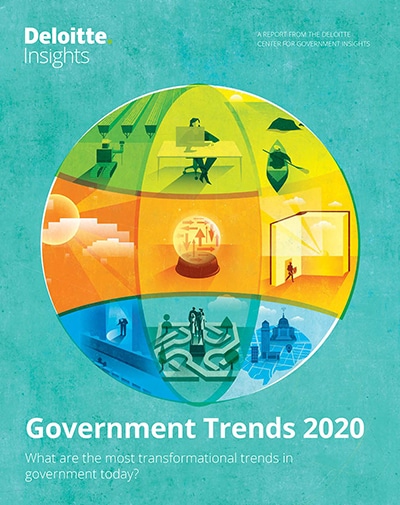
Anticipatory government Preempting problems through predictive analytics
6 minute read
24 June 2019
The idea that government should focus more on preventing problems than just reacting to them is not new. Today, however, advances in predictive analytics allow more governments to work toward preempting problems.
Predictive analytics and artificial intelligence (AI) allow governments to target likely problems before they erupt into crises. Recent advancements in natural language processing (NLP), machine learning, and speech and image recognition have made it possible for government to predict and anticipate problems rather than react to them. From spotting fraud to combatting the opioid epidemic, an ounce of prevention really is worth a pound of cure—especially in government. Predictive analytics is now being applied in a wide range of areas including defense, security, health care, and human services, among others.
Learn more
Download the full report or create a custom PDF
In a hurry? Read a brief version from Deloitte Review, issue 26
Create a custom PDF or download the issue
Learn about Deloitte’s services
Go straight to smart. Get the Deloitte Insights app
The idea that government should focus more on preventing problems instead of just reacting to them is not new.1 What’s different today is the ability to actually do this regularly—and successfully—via an exponential increase in the ability to analyze massive historical data sets and millions of pages of unstructured text to identify patterns and forecast potential problems. This is leading more and more governments to direct resources toward fixing problems before they arise. For instance, the US Air Force has used predictive maintenance technology in an effort to predict when an aircraft may break down and then carry out preventive replacements and maintenance to avoid it. This reduces aircraft downtime and helps minimize future repair costs.2
Governments now use data analytics to inform preemptive measures for a host of issues:
Reduce crime. The police department of Durham, North Carolina, uses AI to observe patterns and interrelations in criminal activities and to identify hotspots with a high incidence of crime, thus allowing for quicker interventions. This helped contribute to a 39 percent drop in violent crime in Durham from 2007 to 2014.3 Meanwhile, the Los Angeles Police Department’s predictive models have helped predict crime events twice as accurately as trained crime analysts.4 The models enable the department to decide where police officers should be deployed in the city to prevent crime.5 Predictive analytics can also be used to help predict financial crimes such as tax evasion and insider trading.6

Fight human trafficking. About 75 percent of child trafficking involves online advertisements according to one survey.7 The Defense Advanced Research Projects Agency (DARPA), in collaboration with commercial technology experts, has developed a platform that monitors dubious online advertisements and infers connections between them and trafficking rings. Both Virginia’s Fairfax County Police Department and Homeland Security Investigations in New Orleans use this advanced software to identify high-risk Web advertisements and detect code words used by traffickers.8 This type of software has helped agencies locate and rescue millions of victims and prosecute traffickers.9
Improve food inspections. How do food safety inspectors prioritize which restaurants or hotels to inspect? Can they predict ahead of time which establishments are the most likely to have food safety issues? Thanks to analytics, increasingly the answer is yes. For instance, the city of Las Vegas’s health department used advanced AI technologies such as NLP to analyze more than 16,000 tweets daily for food-poisoning-related clues (for phrases such as “I feel nauseous,” for example) to help detect venues likely to pose public health hazards.10
Prepare for natural disasters. The government of Indonesia has teamed up with a local startup to predict and manage floods. By using historical flood data collected via sensors and tapping into citizen complaint data, it can identify flood-prone areas.11 Jakarta’s emergency management agency used the data to identify flood locations, expedite its response in managing floods, and communicate and alert citizens about floods.12
Reduce homelessness. The US Department of Veterans Affairs’ National Center on Homelessness Among Veterans is deconstructing big data and developing predictive models to estimate future levels of homelessness. The agency works to identify which veterans are at risk for homelessness so appropriate preventive interventions can be taken.13
Predict cyberattacks. Predictive analytics can sift through a large set of data to identify malicious code, anomalous patterns, and network threats to help predict cyberattacks. This allows governments to take a proactive approach rather than a reactive stance.14 In-Q-Tel, a nonprofit venture capital arm of the US intelligence community, invested in Cylance, a company that uses AI-backed technologies to detect and prevent cyber threats. Cylance uses AI to determine which file is safe, which is malicious, and then works to neutralize malicious files before an attack can be executed.15
Prevent child abuse and fatalities. Oklahoma uses AI to try to predict which child welfare cases have the highest risk of turning into fatalities. The model considers a number of factors such as past history, mental health status, records of parents, and intergenerational abuse. The high-risk cases are flagged for caseworkers to prioritize.16
Counter terrorism. Governments are also advancing efforts to tap into a treasure trove of unstructured social media data. The European Union’s Horizon 2020 program, for example, launched an initiative called RED (Real-time Early Detection) Alert, aimed at countering terrorism by using NLP to monitor and analyze social media conversations. RED Alert is designed to provide early alerts of potential propaganda and signs of warfare by identifying online content posted by extremists.17
Prevent accidents. The Behavioural Insights Team (BIT) of the United Kingdom used predictive analytics to reduce traffic accidents in East Sussex. It developed an algorithm based on data collected over a decade which helped the team to predict which type of drivers are at risk of dangerous accidents. The team found that locals who have been previously caught speeding are the ones often getting involved in accidents. In response, the team tweaked the notices sent to offenders caught speeding to persuade them to follow speed limits. The intervention helped reduce reoffending by 20 percent.18
Going forward, government’s use of AI-based predictive analytics is likely to gain momentum provided agencies can overcome certain challenges. These include closing the skills gap, algorithmic bias, balancing investments in new capabilities vis-à-vis existing operational investments, and organizational inertia of using analytics. However, with strong governance, committed leadership, a focus on talent recruitment and development, and new management practices, governments can continue to scale use of predictive analytics.
Data signals
- Thirty-four percent of the chief data officers in the US government use predictive modeling.19
- The Ash Center at Harvard University has identified more than 200 success stories related to the use of data and analytics across the city, county, state, and federal levels in the United States.20
- US$1.5 billion saved in Medicare payments with the use of a predictive analytics tool.21
- According to a Gartner survey, 43 percent of government CIOs across 89 countries are likely to increase technology investment in business intelligence and data analytics in 2019.22
Moving forward
- Establish data governance processes on the collection, storage, and use of data for predictive analytics.
- Don’t wait to create big data sets before performing analysis. Start with whatever data you have.
- Consider which AI technologies (machine learning, NLP, computer vision, etc.) are appropriate for your use case.
- Train users of your predictive models on how to make decisions based on the results of the model. Provide model results to end users in an intuitive and engaging interface.
- Consider investing in analytical services that make it easier for your analytics team to develop machine learning and predictive analytics models.
- Tackle organizational change management proactively as some employees might resist the transition to more data-driven, predictive decision-making.
Potential benefits
- Ensure early intervention and prevention;
- Enable better resource utilization; and
- Increase the efficacy of mission-critical programs.
Risk factors
- Lack of adequate skills in government;
- Concerns about data privacy;
- Complexity and accessibility of data; and
- Potential of algorithmic bias.
Read more about how governments are using predictive analytics in the Analytics in government collection.
© 2021. See Terms of Use for more information.
Explore the collections
-
Citizen experience in government takes center stage Article5 years ago
-
Smart government Article5 years ago
-
The rise of data and AI ethics Article5 years ago
-
The digital citizen Article5 years ago
-
AI-augmented government Article5 years ago
-
Government Trends 2024 Article1 year ago















